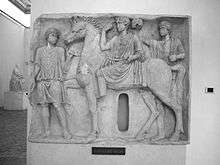Carmen Saliare


The Carmen Saliare is a fragment of archaic Latin, which played a part in the rituals performed by the Salii (Salian priests, aka "leaping priests") of Ancient Rome.[1] There are 35 extant fragments of the Carmen Saliare, which can be read in Morel's FPL.[2]
The rituals revolved around Mars and Quirinus, and were performed in March and October. These involved processions in which they donned archaic armour and weapons, performed their sacred dance, and sang the Carmen Saliare. As a body they existed before the founding of the Roman Republic, tracing their origin back to the reign of Numa Pompilius. The Salian priests were chosen from the sons of patrician families whose parents were still living. They were appointed for life, though they were allowed to resign from the Salian priesthood if they achieved a more prestigious priesthood or a major magistracy.
Fragments 1 and 3 of the hymn have been preserved by Marcus Terentius Varro in his De Lingua Latina, 7.26, 27,[3] and fragment 2 by Quintus Terentius Scaurus in his De orthographia. They say:
| Text | || | Translation |
|---|---|---|
| divum +empta+ cante, divum deo supplicate cume tonas, Leucesie, prae tet tremonti |
Sing of him, the father of the gods! Appeal to the God of gods! When thou thunderest, O God of light, they tremble before thee! |
or
- ... cume tonas, Leucesie, prae tet tremonti quom tibi cunei decstumum tonaront ...
The interpretation of the text has posed difficulties. The Latin words that are easily recognizable in it appear to mention thunder, Janus, and Ceres. Even in the first century BC, Cicero was unable to interpret much of the chant.
The mysterious cozeulodorieso has attracted several proposals. Julius Pomponius Laetus proposed in his editio princeps the interpretation osculo dolori ero "I shall be as a kiss to grief", though his emendations are now dismissed as "editorial fantasy".[4] George Hempl restored it more carefully to coceulod orieso, attested in some manuscripts aside from the spacing, which is good archaic Latin for classical cucūlō oriēre "(thou shalt) come forth with the cuckoo".[5]
See also
References
- ↑ Clifford Ando; Jörg Rüpke (2006). Religion and Law in Classical and Christian Rome. Franz Steiner Verlag. pp. 18–. ISBN 978-3-515-08854-1.
- ↑ FPL=Fragmenta poetarum latinorum epicorum et lyricorum: praeter enni annales et Ciceronis Germanicique Aratea, originally compiled by W. Morel 1927, 2nd edition by C. Büchner 1982, 3rd and 4th editions by J. Blänsdorf in 1995 and 2011.
- ↑ http://latin.packhum.org/loc/684/1/0#39
- ↑ Sarullo, Giulia; Taylor, Daniel J. (December 2013). "Two Fragments of the Carmen Saliare and the Manuscript Tradition of Varro's De Lingua Latina". Codices Manuscripti & Impressi. 91/92: 1–10.
- ↑ Hempl, George (1899). "The Origin of the Latin Letters G and Z". Transactions and Proceedings of the American Philological Association. The Johns Hopkins University Press. 30: 24–41. doi:10.2307/282560. JSTOR 282560.
External links
- Original text of Carmen Saliare